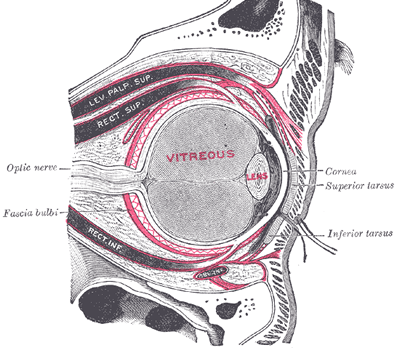Cosmetic eyelid surgery (Blepharoplasty)
See also Dr Kremer's signature "Turn Back Time" TBT eyelid lift blepharoplasty procedure.
Harley St Aesthetics offers London eyelid surgery performed by top plastic surgeon Dr Dirk Kremer. Read about the blepharoplasty procedure, and get in touch with Dr Kremer to discuss if eyelid surgery is right for you.
Upper eyelid
With increasing age there may be a hang of the upper eyelids. This leads to a weary expression that is perceived by many patients as disturbing. Younger patients complain of swelling of congenital upper eyelid, so-called drooping eyelids.
In both cases, blepharoplasty can help to regain a fresh, radiant face.
In this operation performed by London plastic surgeon Dr Dirk Kremer, a cut is made in the natural skin fold of the upper lid. Excess skin and fat are removed and tightened if necessary from the orbital septum. After closure of the incision, the scar is in the skin fold of the upper lid, and therefore hardly visible.
Lower eyelid
 The so-called tear bags are actually made of fatty tissue that bulges into the lower lid more with increasing age. This natural ageing process leads to an unpleasant change in the eye area and affects a youthful visage. A barely visible cut is made just below the lashes of the under lid, to remove the bulging fat and restore the septum to its original "youthful" position. If there are sufficient excess skin folds, a small strip of the eyelid is surgically removed. After wound closure there remains a fine, thin line that follows the natural skin folds.
The so-called tear bags are actually made of fatty tissue that bulges into the lower lid more with increasing age. This natural ageing process leads to an unpleasant change in the eye area and affects a youthful visage. A barely visible cut is made just below the lashes of the under lid, to remove the bulging fat and restore the septum to its original "youthful" position. If there are sufficient excess skin folds, a small strip of the eyelid is surgically removed. After wound closure there remains a fine, thin line that follows the natural skin folds.
References:
- Orbit - In anatomy, the orbital bone is the cavity or socket of the skull in which the eye and its appendages are situated.
- Orbital Septum - The orbital septum (palpebral ligament) is a membranous sheet that acts as the anterior boundary of the orbit. It extends from the orbital rims to the eyelids. It forms the fibrous portion of the eyelids.
Eyelid surgery
Before:


After:


Six months later:

What risks does a blepharoplasty bring with it?
In general, surgery on the eyelids has a very low associated risk factor. However, during an operation complications can never be completely ruled out and in some cases unpredictable results can occur.
Swelling and bruising
The extent and duration of swelling and bruising after the operation are very different and individually marked.
Infection
Infection of the wound area is extremely rare. With proper treatment the result does not necessarily deteriorate.
Impaired wound healing in the lids is also very rare. Additional factors usually play a role in delayed healing, such as in diabetics, smokers or patients with bleeding disorders. These risk factors should be included in the detailed patient interview.
Infection in the lower eyelids can cause a distortion or deformity of the lower lid. This is a very unpleasant complication and is rare. If infected tissue is removed to prevent infection or wound healing, it can lead to a distortion of the eyelid. Massage of the lower lid can rectify the result, or else we do a corrective operation.
When selecting a good surgeon with diligence and compliance the desired postoperative aesthetic result is generally achieved without complications and with good success. If you would like to discuss any other risks associated with the operation, you can talk to Dr Dirk Kremer in your pre-op consultation.
How do I prepare myself for the operation of the Blepharoplasty?
It is advisable to plan for around seven days off after the operation. This will give your procedure time to heal and for the proper results to become evident.
In the days before eyelid surgery, you should also take the time to be rested mentally and physically.
Aspirin and similar blood-thinning medications should for their inhibitory effect on blood clotting not be consumed for at least 1-2 weeks before surgery. For questions and doubts before the surgery, please call your surgeon in Harley Street.
Where is the surgery?
Lid tightening will be an outpatient procedure as a rule. After surgery, you will have a short recovery and observation period before going home. In no case should you ever drive a car.
What is used for anaesthesia?
In general, eyelid surgery is performed under local anaesthesia. With local anaesthesia, you will also receive a sedative (either as a tablet or by intravenous injection in the arm vein) which puts you in a kind of twilight sleep; you are awake, but relaxed and insensitive to pain.
Prior to the operation, if general anaesthesia is planned you will have a consultation and discuss the procedure with your anaesthesiologist. In this case he/she will monitor you throughout the operation controlling the anaesthetic.
However, general anaesthesia is usually the exception.
About the plastic surgery
A tightening of the eyelids usually takes about 45-60 minutes, depending on how pronounced is the result. The streamlining of the lower eyelids takes about the same time.
The plastic surgery is as follows:
Upper eyelid:
In the natural crease of the upper lid the incision is made, this runs out laterally just above the outer edge of the lid in the so-called laugh lines.
How much skin is removed will be assessed before the operation and determined by alternately closing the eyes.
The designated skin is then dissected and removed from the underlying muscle.
After dividing the superficial eye sphincter, a very fine membrane (septum) is cut and thereafter, the pre-expressed fat in the eyelid is removed.
In order to operate on tissue preservation, a tightening of the sagging septum is performed and positioned back into the orbit. This method is useful, especially in younger patients, as you can assume that in the course of life (usually after 10-12 years) a renewed tightening of the eyelids will be required. Thereafter, the upper lid is again closed with a continuous, outwardly invisible skin suture.
Lower eyelid:
With the lower eyelid, an incision is made just below the eyelashes.
It cuts through the skin and allows the underlying subcutaneous tissue and muscle to be gently lifted.
After partial transection of the annular sphincter at the lower eyelid, and the opening of the septum away from the orbit to the lower eyelid, fat is gently pushed forward. This fat gives the patient the appearance of the popularly known "eye bags". Then the excess skin is removed very carefully and strictly, followed by the closure of the eyelid with a continuous, outwardly invisible skin suture.
What is a transconjunctival blepharoplasty?
Blepharoplasty is usually performed through external incisions made along the natural skin lines of the eyelids, such as the creases of the upper lids and below the lashes of the lower lids. Incisions may be made from the inside surface of the lower eyelid (
What must be done if the eyelid surgery?
The first 24 hours after surgery (Blepharoplasty):- Sleep with your head elevated, and avoid any effort that could increase your blood pressure. If possible, stay rested in bed for the first 24hrs.
- Do not drink caffeinated beverages.
- Cool your eyes with Eisbrille or cover your wound dressings in crushed ice. Place gently on the eye and replace hourly in the first 24hrs. Pay attention to your fresh seams.
- Please take medication prescribed by a doctor as directed. In general, only blood-thinning agents such as aspirin should be taken before and after surgery.
Talk with your surgeon, Dr Dirk Kremer, if you:
- Experience eye pain. A slight burning of the eyelids is normal.
- Have vision problems. Due to the swelling of the eyelids after the surgery, a low blurred vision is not unusual.
- Experience sudden swelling or bleeding.
Eye Care:
- Bathe your eyes as often as possible in the first three days after the Blepharoplasty.
- Stitches are usually removed 4-5 days after blepharoplasty. Then wait another 2 days before applying makeup to the eyes.
- Contact lenses can be worn again, once you are no longer uncomfortable. If possible, however, one should wear glasses, so as not to disturb the lid when inserting the lenses, during the healing of the sutures.
- Because of certain sensitivity in the first days after the blepharoplasty, sunglasses can be worn and can also be very useful in concealing the effect.
- Reading and television should be avoided in the first 2 days.
General advice after blepharoplasty
- In the first week after eyelid surgery you should sleep on your back with your head elevated.
- Rest as much as possible in the first 2 weeks.
- Most of the swelling will subside within the first week.
- Sometimes the whites of the eyes become slightly discoloured, with a bluish tint. This change is painless and does not affect your eyesight, and quickly reverts back to normal.
- Some weeks after a blepharoplasty, the formation of small white nodules called milia can occur on the eyelids. This can easily be removed by your doctor during a visit to the practice.
- If you experience light burning and tearing of the eyes after eyelid surgery, appropriate eye drops are applied.
-----------------------------------------------------------------------------------------------------------------------------------------------------------------------------------------------------
FAQ
I am afraid of general anaesthesia. Can I do the eyelift under local anaesthesia?
I always perform my upper eyelifts under local anaesthesia. Using a general anaesthesia for an upper eyelift isn't necessary.
When performing a lower eyelift I prefer my patients to be sedated which means that an anaesthetist will place an IV line and administer analgesics and sedatives during your surgery which will relax you and help you fall asleep. At all times you with breath naturally, and once the procedure is finished, you will immediately wake up. In a lower eyelift I cut right under your eyelashes where I also will place my sutures. This can be a stressful experience for a patient, but technically it is possible to also perform the lower eyelift under local anaesthesia.
How long does the eyelift take?
An upper eyelift takes about 40 min. A lower eyelift takes about 45 min.
What are the complications?
My TBT-eyelift (upper eyelift) has very minimal risks and complications. General complications after surgery such as infection and wound healing problems are very minimal. The known and dangerous complications are blinding, hanging eyelid and dry eyes, and are commonly connected to the traditional upper eyelift in which the plastic surgeon cuts the orbital septum and removes orbital fat. Since my TBT-eyelift only creates a very superficial wound these risks don’t occur.
In a lower eyelift, the most severe complication is the development of an ectropion which can be avoided if all the steps of the eyelift are carefully performed. Still, conjunctivitis or a severe swelling can cause an ectropion which is usually temporary. During the time you have an ectropion, your lower eyelid will be taped and antibiotic eye drops will be given.
How long do I need to stay in the hospital?
If performed under local anaesthesia you will leave the hospital right after your eyelift. If performed under sedation we keep you for a few hours in the hospital before you can leave. Under normal circumstances, you will not have to stay overnight following an eyelift.
Does an eyelift hurt?
When the local anaesthetic wears off a few hours after your eyelift, you might feel a discomfort which can be treated with paracetamol 500 mg. In the next morning you will have very little pain.
How long do I wear plasters?
Your plasters and stitches will be removed after 5 days.
Do I have drains?
No, there are no drains in an eyelift.
What can I expect once at home?
Once at home you might experience some slight pain or discomfort. This will improve when you take paracetamol 500mg. Prepare some cold packs which you should apply as soon as you are at home. Due to the fine plasters which are over the incision which runs exactly in the fold of your upper eyelids you might feel a pressure when you want to open your eyes. This is normal and should get better over the next days once the swelling settles. Once the plasters are removed this feeling will be gone. In the next morning, your eyelids might be swollen, some patients report that they could hardly open their eyes. This will settle over the day and improve each morning. Bruising usually shows over the lower eyelid even though they were not touched. This is due to gravity which pulls the bruises of the upper eyelids down over the lower eyelids. They will fade with time. You are welcome to apply concealer. The next day you can go back to your routine - of course wearing sunglasses to keep your eyelift a secret if needed. For a few weeks you might feel a tightness over your eyes as if you wore swim goggles. This is caused by the dissolvable suture which tightens your orbital septum. Once the sutures are dissolved the feeling will fade away. Once your plasters and stitches are removed you will see a good difference but you are certainly still swollen. This will settle over the nest days. Family and friends will soon recognise a great result even though you will feel that you are still healing. Give it time to heal for a few more weeks. You can immediately put eyeshadow on. Week by week you will see an improvement. Give it a full 6 weeks before judging the end result.
Weeks and even months after you eyelift you can develop so-called milia within the scar. These are tiny pimples which can grow bigger when not emptied manually. They are caused by obstructed ducts of the many sebaceous glands in your eyelid.
A lot of patients will feel and see a lump under the lateral end of the scar of the upper eyelid. This is the knot of the suture which reinforces your orbital septum. You can gently massage it against the underlying bone to speed up the dissolving process.
What should I do to not risk a complication and ensure my eyelift heals correctly?
The most important thing to avoid is high blood pressure in the first two days which can cause bleeding and bruising. Avoid coffee and black tea as well as any sports and don’t bend over. After a lower eyelift or a combined procedure - upper and lower eyelift - keep your eyes clean. Avoid eyelashes that stick together or poke onto your sclera. This can cause conjunctivitis which can cause a temporary ectropion. The healing of the eyelids will be prolonged. In the worst case scenario a prolonged conjunctivitis can result in a remaining ectropion.
How long do I need to stay at home? When can I go back to work?
You don’t need to hide after an eyelift. With sunglasses on you can go back to your daily routine the next day. If you want to keep your eyelift a secret at your workplace, wait until I will remove your plasters and stitches after 5 days. After stitches are removed patients can go back to work. In case they have bruises they can be covered with concealer.
Where are the incisions? Will the scars be visible?
In an upper eyelift, your incision and later scar will ideally run in the fold of your upper eyelid. Depending on if your lateral eyelid is very heavy or not and needs to be lifted, your incision might end on the side of your eyes in your laugh lines. Once healed the scar becomes almost invisible.
In a lower eyelift, your incision and later scar is running right under your eyelashes and will end laterally descending into your laugh lines. They are hardly visible after a few weeks..
How long does the result last?
The results should last for up to 15 years and of course is dependant on your genes and skin care regime.
When are the stitches removed?
Stitches are removed after 5 days.
How often do I see you after surgery?
You will see me after your eyelift 5 days post-op to remove your stitches, and 6 weeks after your surgery for your follow-up and sign-off.
Book a Consultation
Dr Kremer conducts virtual consultations via WhatsApp or Zoom and in-person consultations at our office in Harley Street, London. If you would like to book a consultation, or would like more information, simply get in touch with us via phone, email or through our contact form and we will schedule a date and time for your consultation.








